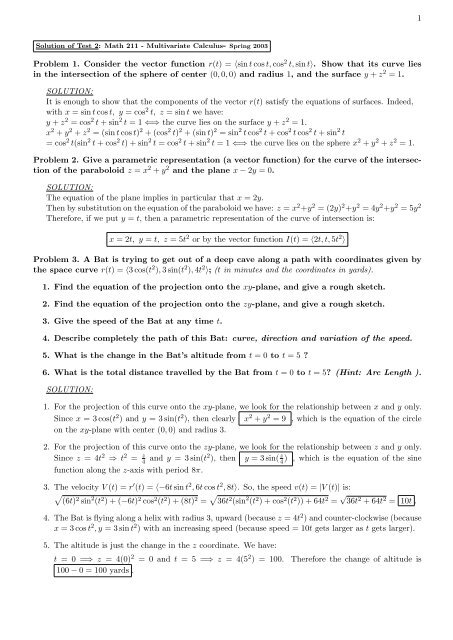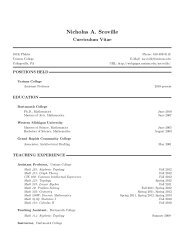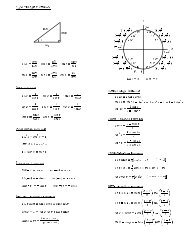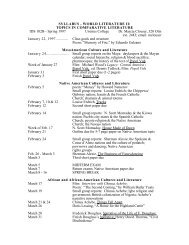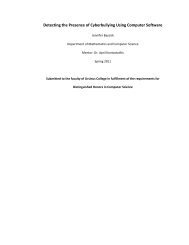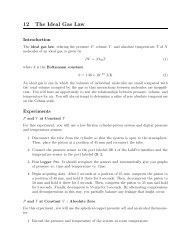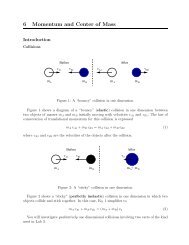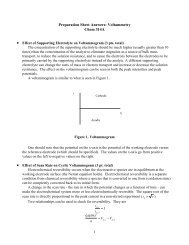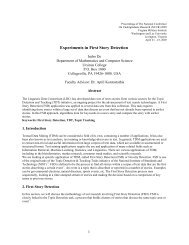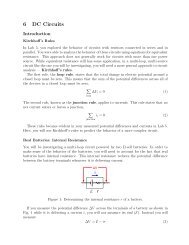1 Problem 1. Consider the vector function r(t) = 〈sintcost,cos 2 t,sint ...
1 Problem 1. Consider the vector function r(t) = 〈sintcost,cos 2 t,sint ...
1 Problem 1. Consider the vector function r(t) = 〈sintcost,cos 2 t,sint ...
You also want an ePaper? Increase the reach of your titles
YUMPU automatically turns print PDFs into web optimized ePapers that Google loves.
1Solution of Test 2: Math 211 - Multivariate Calculus- Spring 2003<strong>Problem</strong> <strong>1.</strong> <strong>Consider</strong> <strong>the</strong> <strong>vector</strong> <strong>function</strong> r(t) = 〈sin t <strong>cos</strong> t, <strong>cos</strong> 2 t, sin t〉. Show that its curve liesin <strong>the</strong> intersection of <strong>the</strong> sphere of center (0, 0, 0) and radius 1, and <strong>the</strong> surface y + z 2 = <strong>1.</strong>SOLUTION:It is enough to show that <strong>the</strong> components of <strong>the</strong> <strong>vector</strong> r(t) satisfy <strong>the</strong> equations of surfaces. Indeed,with x = sin t <strong>cos</strong> t, y = <strong>cos</strong> 2 t, z = sin t we have:y + z 2 = <strong>cos</strong> 2 t + sin 2 t = 1 ⇐⇒ <strong>the</strong> curve lies on <strong>the</strong> surface y + z 2 = <strong>1.</strong>x 2 + y 2 + z 2 = (sin t <strong>cos</strong> t) 2 + (<strong>cos</strong> 2 t) 2 + (sin t) 2 = sin 2 t <strong>cos</strong> 2 t + <strong>cos</strong> 2 t <strong>cos</strong> 2 t + sin 2 t= <strong>cos</strong> 2 t(sin 2 t + <strong>cos</strong> 2 t) + sin 2 t = <strong>cos</strong> 2 t + sin 2 t = 1 ⇐⇒ <strong>the</strong> curve lies on <strong>the</strong> sphere x 2 + y 2 + z 2 = <strong>1.</strong><strong>Problem</strong> 2. Give a parametric representation (a <strong>vector</strong> <strong>function</strong>) for <strong>the</strong> curve of <strong>the</strong> intersectionof <strong>the</strong> paraboloid z = x 2 + y 2 and <strong>the</strong> plane x − 2y = 0.SOLUTION:The equation of <strong>the</strong> plane implies in particular that x = 2y.Then by substitution on <strong>the</strong> equation of <strong>the</strong> paraboloid we have: z = x 2 +y 2 = (2y) 2 +y 2 = 4y 2 +y 2 = 5y 2Therefore, if we put y = t, <strong>the</strong>n a parametric representation of <strong>the</strong> curve of intersection is:x = 2t, y = t, z = 5t 2 or by <strong>the</strong> <strong>vector</strong> <strong>function</strong> I(t) = 〈2t, t, 5t 2 〉<strong>Problem</strong> 3. A Bat is trying to get out of a deep cave along a path with coordinates given by<strong>the</strong> space curve r(t) = 〈3 <strong>cos</strong>(t 2 ), 3 sin(t 2 ), 4t 2 〉; (t in minutes and <strong>the</strong> coordinates in yards).<strong>1.</strong> Find <strong>the</strong> equation of <strong>the</strong> projection onto <strong>the</strong> xy-plane, and give a rough sketch.2. Find <strong>the</strong> equation of <strong>the</strong> projection onto <strong>the</strong> zy-plane, and give a rough sketch.3. Give <strong>the</strong> speed of <strong>the</strong> Bat at any time t.4. Describe completely <strong>the</strong> path of this Bat: curve, direction and variation of <strong>the</strong> speed.5. What is <strong>the</strong> change in <strong>the</strong> Bat’s altitude from t = 0 to t = 5 ?6. What is <strong>the</strong> total distance travelled by <strong>the</strong> Bat from t = 0 to t = 5? (Hint: Arc Length ).SOLUTION:<strong>1.</strong> For <strong>the</strong> projection of this curve onto <strong>the</strong> xy-plane, we look for <strong>the</strong> relationship between x and y only.Since x = 3 <strong>cos</strong>(t 2 ) and y = 3 sin(t 2 ), <strong>the</strong>n clearly x 2 + y 2 = 9 , which is <strong>the</strong> equation of <strong>the</strong> circleon <strong>the</strong> xy-plane with center (0, 0) and radius 3.2. For <strong>the</strong> projection of this curve onto <strong>the</strong> zy-plane, we look for <strong>the</strong> relationship between z and y only.Since z = 4t 2 ⇒ t 2 = z 4 and y = 3 sin(t2 ), <strong>the</strong>n y = 3 sin( z 4) , which is <strong>the</strong> equation of <strong>the</strong> sine<strong>function</strong> along <strong>the</strong> z-axis with period 8π.3. The velocity V (t) = r ′ (t) = 〈−6t sin t 2 , 6t <strong>cos</strong> t 2 , 8t〉. So, <strong>the</strong> speed v(t) = |V (t)| is:√(6t) 2 sin 2 (t 2 ) + (−6t) 2 <strong>cos</strong> 2 (t 2 ) + (8t) 2 = √ 36t 2 (sin 2 (t 2 ) + <strong>cos</strong> 2 (t 2 )) + 64t 2 = √ 36t 2 + 64t 2 = 10t .4. The Bat is flying along a helix with radius 3, upward (because z = 4t 2 ) and counter-clockwise (becausex = 3 <strong>cos</strong> t 2 , y = 3 sin t 2 ) with an increasing speed (because speed = 10t gets larger as t gets larger).5. The altitude is just <strong>the</strong> change in <strong>the</strong> z coordinate. We have:t = 0 =⇒ z = 4(0) 2 = 0 and t = 5 =⇒ z = 4(5 2 ) = 100.100 − 0 = 100 yards .Therefore <strong>the</strong> change of altitude is
26. The distance travelled is exactly <strong>the</strong> arc length between t = 0 to t = 5, which is given by:∫ 50∣∣r ′ (t) ∣ dt =∫ 5010tdt = [10 t2 2 ]5 0 = 125<strong>Problem</strong> 4. <strong>Consider</strong> r(t) = 〈3t + 2, t 2 , 4t〉. Find each of <strong>the</strong> following at <strong>the</strong> point P(2, 0, 0):<strong>1.</strong> The unit Tangent <strong>vector</strong> T at P2. The Normal <strong>vector</strong> N at P3. The equation of <strong>the</strong> Normal Plane at P4. The curvature K at P .SOLUTION:First, <strong>the</strong> point P corresponds to t = 0.r(t) = 〈3t + 2, t 2 , 4t〉, <strong>the</strong>n r ′ (t) = 〈3, 2t, 4〉 and |r ′ (t)| = √ 3 2 + (2t) 2 + 4 2 = √ 25 + 4t 2<strong>1.</strong> T (t) = r′ (t)|r ′ (t)| = 1√ 〈3, 2t, 4〉. At P , T = T (0) = 1 〈3, 0, 4〉25 + 4t 2 52. The normal <strong>vector</strong> is given by N = T ′ (0)|T ′ (0)| . First we need to first T ′ (t).T ′ 1(t) = ( √ 〈3, 2t, 25 + 4t 2 4〉)′ = −12 4t(25 + 4t2 ) −321〈3, 2t, 4〉 + √ 〈0, 2, 0〉. So, for t = 0 we have:25 + 4t 2T ′ (0) = 0 + √ 1 〈0, 2, 〉 = 〈0, 2 25 5 , 0〉 and ∣ ∣T ′ (0) ∣ = 2 5 . Therefore N = T ′ (0)|T ′ = 〈0, 1, 0〉(0)|3. The normal plane has T = 1 5〈3, 0, 4〉 as a normal <strong>vector</strong> and passes through <strong>the</strong> point P (2, 0, 0).1<strong>the</strong>refore its equation os given by:5[3(x − 2) + 0(y − 0) + 4(z − 0)] = 0 =⇒ 3x + 4z = 64. The curvature is given by K = |T ′ 2(0)||r ′ (0)| = 55 = 2 25 .<strong>Problem</strong> 5. <strong>Consider</strong> <strong>the</strong> <strong>function</strong> f(x, y) = √ 8 − x 2 − y 2 + 2x.<strong>1.</strong> Find and sketch <strong>the</strong> domain of this <strong>function</strong>. (Hint: completing <strong>the</strong> square)2. Describe in words <strong>the</strong> graph of this <strong>function</strong>3. Describe and give a rough sketch of <strong>the</strong> level curves for k = 0, 1, 2, 3.SOLUTION:<strong>1.</strong> f(x, y) exists if 8−x 2 −y 2 +2x ≤ 0. Since 8−x 2 −y 2 +2x = 0 ⇐⇒ 8 = x 2 +y 2 −2x ⇐⇒ 9 = (x−1) 2 +y 2 ,which is <strong>the</strong> circle on <strong>the</strong> xy-plane of center (1, 0) and radius 3, <strong>the</strong>n <strong>the</strong> domain is <strong>the</strong> inside of thiscircle with <strong>the</strong> circle included.2. Since z = √ 8 − x 2 − y 2 + 2x, <strong>the</strong>n z 2 = 8−x 2 −y 2 +2x ⇒ x 2 +y 2 −2x+z 2 = 8 ⇒ (x−1) 2 +y 2 +z 2 = 9,which is (because z is positive) <strong>the</strong> upper-half of <strong>the</strong> sphere of center(1, 0, 0) and radius 3.3. With z = k we have (x − 1) 2 + y 2 + k 2 = 9 =⇒ (x − 1) 2 + y 2 = 9 − k 2k = 0 =⇒ (x − 1) 2 + y 2 = 9 =⇒ circle of center (1, 0) and radius 3.k = 1 =⇒ (x − 1) 2 + y 2 = 8 =⇒ circle of center (1, 0) and radius √ 8.k = 2 =⇒ (x − 1) 2 + y 2 = 5 =⇒ circle of center (1, 0) and radius √ 5.k = 3 =⇒ (x − 1) 2 + y 2 = 0 =⇒ <strong>the</strong> point (1, 0) only.


